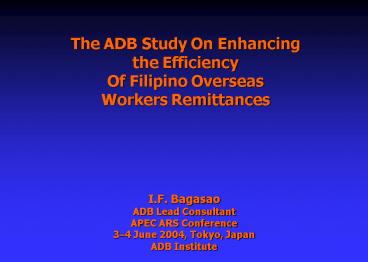ADB Structure - PowerPoint PPT Presentation
1 / 16
Title:
ADB Structure
Description:
Objectives of the Study on Flows of Remittances. To possibly ... OFW E-cards. 7. Remittance Behaviour. 80% are remitting through banking or regulated channels. ... – PowerPoint PPT presentation
Number of Views:91
Avg rating:3.0/5.0
Title: ADB Structure
1
The ADB Study On Enhancing the Efficiency Of
Filipino Overseas Workers Remittances
I.F. Bagasao ADB Lead Consultant APEC ARS
Conference 34 June 2004, Tokyo, Japan ADB
Institute
2
Stocks of Overseas Filipinos
2
3
Objectives of the Study on Flows of Remittances
- To possibly increase remittance volumes.
- Facilitate shift from informal to formal or
regulated channels. - Encourage the use of remittances for sustainable
poverty reduction.
3
4
Characteristics of Flows
- Outflows are 2,700 daily / almost 1 million
annually. - 197 Destination Economies Mostly in ME,
Southasia and US. - Landbased and Seabased Workers.
- Professionals and Service Workers.
- 65 to 70 of contract based are female.
4
5
Remittance Characteristics
- Formal Flows of US7.6 million in 2003.
- Unregulated Flows consist of
- Sent through unregulated ethnic stores, mail,
cargo boxes. - Sent through friends.
- Cash brought home.
- Goods sent home.
5
6
Remittance Players
- Philippine Banks.
- Philippine Money Transfer Agencies
- International Money Transfer Agencies
- Host Country Banks
6
7
Remittance Trends
- Vibrant Competition due to long history of
Philippine overseas deployment. - Convergence of services through partnerships,
alliances and revenue sharing. - New Players and technology or card based
remittance products - Mobile Phones
- Internet based services
- Card Products
- Postal Office
- Entry of non traditional players (credit unions,
coops) - OFW E-cards
7
8
Remittance Behaviour
- 80 are remitting through banking or regulated
channels. - 70 maintain bank accounts in the Philippines.
- 90 save.
- Average amount of remittance sent is US340.
- Use of remittances preponderant for food,
utilities, personal care and dwelling related
expenses. - Majority are interested to help contribute to
community development. - From 41 to 49 incur debt to migrate.
8
9
Barriers to Remittance Flows
- Anti-money laundering compliance.
- First Mile IssuesLicensing costs / restrictive
laws in certain countries. - The Unbanked on both first and last mile.
- Uneven Application of AML compliance.
- Funding problems to upgrade infrastructure
affects local and international interconnectivity.
9
10
Non Bank Related Factors
- Demand for Filipino workers.
- Financial burdens on OFWs.
- Inadequate financial orientation for departing
workers. - Workplace related (taxes and levies, abuses on
employment terms).
10
11
The Extra MileWhat can government, the private
sector and civil society do to enhance formal
remittance flows?
- Financial Literacy and Information Programs.
- Identify and support Best Practices on Remittance
Leveraging of NGOs and LGUs. - Strengthen rural based financial and economic
organizations by improving interconnectivity. - Organise and support initiatives of Filipino
Associations Overseas. - Study and institute proper incentives system.
11
12
Bilateral Initiatives to help create efficient
and competitive international Remittance Channels
- Foster deeper understanding of first and last
mile concerns. - Dialogues thresh out problems and offer
solutions. - MOI between US and the Philippines.
12
13
Education of Migrant Workers and Families on
sending and receiving issues in remittances
- Financial literacy and remittance orientation in
predeparture. - NGOs can help in financial literacy programs at
village level. - Money Transfer agencies could help in financial
literacy and promoting bank transfer mechanisms.
13
14
Implications for Multilaterals and Regional
Groupings
- Link emerging best practices on formal remittance
flows and leveraging of remittances to
development programs. - Technical assistance and funding support for
upgrading of banking technology and improve
interconnectivity. - Increase dialogues and include migration and
remittance issues as regular discussion points in
conferences and discussions.
14
15
Conclusion
16
Thank you.































